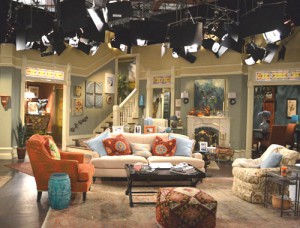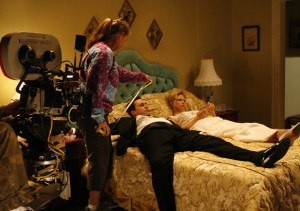The Aesthetic Turn: Toward a Television Aesthetic (Again)
 In the context of a course I’m teaching for the second time, Film and Television Aesthetics, I have been thinking a great deal about not only how to teach television aesthetics, but also what it means to analyze or evaluate television aesthetics. As evidenced by this series, The Aesthetic Turn, this is again something that scholars and television audiences want to discuss. It is not that television aesthetics has been an afterthought in the last twenty years; rather, somewhere along the way I think it was pushed aside for other important and topical research.
In the context of a course I’m teaching for the second time, Film and Television Aesthetics, I have been thinking a great deal about not only how to teach television aesthetics, but also what it means to analyze or evaluate television aesthetics. As evidenced by this series, The Aesthetic Turn, this is again something that scholars and television audiences want to discuss. It is not that television aesthetics has been an afterthought in the last twenty years; rather, somewhere along the way I think it was pushed aside for other important and topical research.
My own interest in writing this piece was sparked when I read Fred E. H. Schroeder’s 1973 essay “Video Aesthetics and Serial Art,” in the first edition of Horace Newcomb’s edited anthology Television: The Critical View (1976). The articles contemplating television aesthetics, such as Schroeder’s and Newcomb’s “Toward a Television Aesthetic,” disappear in later editions of this book. As Jonathan Gray and Amanda Lotz note in their book Television Studies, “the contents of the volume shifted considerably from journalists to academics over the first few editions” (18). Indeed, Gray and Lotz make a “gentle call” for a “more successful reintegration of aesthetics and critical analysis” as a “key frontier” for the future of television studies (53). This type of work exists, even if it does not explicitly call itself that: Julie D’Acci’s Defining Women: Television and the Case of Cagney & Lacey, Jeremy Butler’s Television Style, and a whole section of essays in Ethan Thompson and Jason Mittell’s How to Watch Television. But why hasn’t there been a bigger return to this analytical area?
I think there are a few factors that complicate this issue. For one, in the last decade there has been a clear shift in the public perception of television from the denigrated also-ran to a medium taken seriously by viewers as a prominent art form, a reputation that films and filmmakers have enjoyed for several decades. Likewise, aesthetics seems more clearly or naturally articulated in discussion of film than it does with television. Does this speak to a tension in television studies and television scholars, who may want to continue to distance themselves from film studies in regards to carving out its own disciplinary boundaries?
From another perspective, David Thorburn writes about this issue, rooting the problem less in the medium and more in terms of language. In his 1987 paper “Television as an Aesthetic Medium” he writes that “the adjective ‘aesthetic’ is problematic, I realize. But I know no other word to use for the qualities I wish to identify in our popular culture and specifically in our television system” (162). Despite the complicated nature of this term, he notes that he wants to employ it not as “a valuing of aesthetic objects” but rather for use as “a designation of their chief defining feature—their membership in a class of cultural experiences understood to be fictional or imaginary, understood to occur in a symbolic, culturally agreed upon imaginative space” (162).
In yet another way perhaps the early writing set the stage for a complicated relationship between television studies and aesthetics. Some articles from the 1960s and 1970s focus more on what television in this era couldn’t do rather than what it could do. Schroeder writes at length about the smallness of television image and television’s inability to transform “televised” arts within its at-the-time technological parameters. Evelina Tarroni’s article “The Aesthetics of Television” spends considerable time debating whether television is “art” or “merely a technical means of transmission which adds nothing to, and introduces no change, in the subject matter transmitted” (437). These aesthetic contemplations, while worthy of continued examination, are very much products of their time. Articles like this at their core were defensive arguments that had to first convince readers that television is art, and that television isn’t film. Since this line of thinking is less necessary for contemporary audiences, there is no longer a need to differentiate between the ideas that were at the center of these early television aesthetic discussions. These lines have been largely erased, between television actors and film actors, or between television texts and film texts.
From my perspective, what makes the conversation about aesthetics so productive, and instructive, is the reconnection of analyses that consider the form, content, and context of television programs, and relinking cultural studies and television aesthetics in a multitude of texts: old and new television programs; cult, popular, or unpopular programs; particular seasons or series as a whole; special episodes; mythology or monster-of-the week episodes; serial or episodic programs; groups of programs on networks or cable channels; “online” television, etc. In this regard, writers might also want to consider the ways in which different modes of distribution, reception, availability of texts, and their historical trajectories might inform aesthetic analysis.
From my own teaching perspective, I came to these questions and concerns from reading television studies research from the 1970s, but also from what felt like a classroom problem: why is it so easy for my students to talk about the form and content of films I show in class, when they have such difficulties connecting form and content in our analysis of television programs? Is it because television programs are devoid of form? Of course not, so let’s figure this out together.
This is the sixth post in Antenna’s series The Aesthetic Turn, which examines questions of cultural studies and media aesthetics. If you missed any of the earlier posts in the series, they can be read here.


